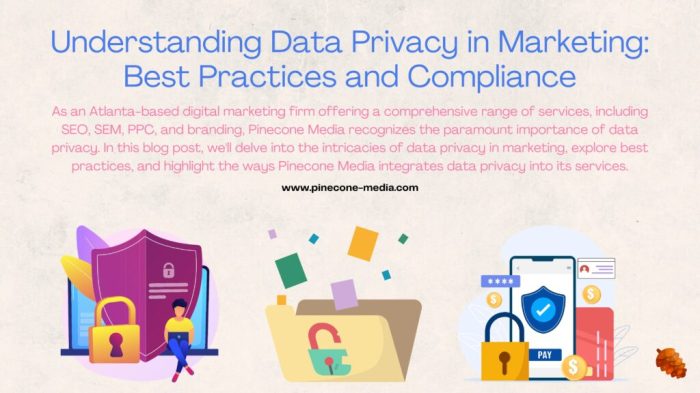Yo, dive into the world of Understanding Marketing Data Privacy where keeping data safe is key in today’s digital game. Get ready for a wild ride filled with insights and strategies to protect consumer info like a pro.
From the importance of data privacy to regulations and compliance, we’ve got you covered with all the juicy details you need to know. So buckle up and let’s roll!
Importance of Marketing Data Privacy: Understanding Marketing Data Privacy
In today’s digital landscape, marketing data privacy is crucial to protect both businesses and consumers from potential risks and harm.
Impact of Breaches in Marketing Data Privacy
- Loss of trust: When consumer data is compromised, it can lead to a loss of trust in the company responsible for safeguarding that information.
- Financial repercussions: Data breaches can result in financial losses due to legal fees, fines, and compensation to affected individuals.
- Damaged reputation: Businesses may suffer reputational damage that can be difficult to recover from, leading to a decline in customer loyalty and brand value.
Ethical Considerations in Handling Marketing Data
- Respect consumer privacy: It is essential to handle marketing data ethically and responsibly to respect the privacy of individuals.
- Transparency and consent: Businesses should be transparent about how they collect, use, and share consumer data, obtaining consent where necessary.
- Accountability: Companies need to be accountable for the data they collect and ensure it is protected from unauthorized access or misuse.
Regulations and Compliance

In today’s digital age, companies must adhere to key regulations to ensure marketing data privacy is protected. Failure to comply with these regulations can have serious consequences, both legally and reputationally. Let’s dive into the details.
General Data Protection Regulation (GDPR)
The GDPR, implemented by the European Union, sets strict guidelines for how companies collect, process, and store personal data. This regulation applies to any organization that handles data of EU citizens, regardless of the company’s location. Companies must obtain explicit consent from individuals before collecting their data, and they must ensure data is kept secure and only used for the intended purpose.
California Consumer Privacy Act (CCPA)
The CCPA, enacted in California, aims to give consumers more control over their personal information. It requires businesses to disclose what data they collect, how it is used, and gives consumers the right to opt-out of the sale of their data. Companies must also provide a way for consumers to request their data be deleted.
Implications of Non-Compliance
Failure to comply with these regulations can result in hefty fines, legal battles, and damage to a company’s reputation. Customers are increasingly aware of the importance of data privacy and are more likely to trust companies that prioritize their privacy. Non-compliance can lead to loss of customer trust and loyalty, ultimately impacting the bottom line.
Ensuring Compliance, Understanding Marketing Data Privacy
To ensure compliance with regulations like GDPR and CCPA, companies must invest in robust data protection measures, such as encryption, access controls, and regular audits. They should also provide clear privacy policies and procedures for handling customer data. Training employees on data privacy best practices is crucial to maintaining compliance and protecting customer information.
Strategies for Secure Data Collection
In today’s digital age, securing marketing data is crucial to maintaining customer trust and complying with regulations. Implementing best practices for data collection can help protect sensitive information and prevent data breaches.
Utilizing Secure Data Collection Methods
- Use HTTPS protocols: Ensure that all data collection forms and websites are encrypted using HTTPS to protect data transmission.
- Implement Multi-Factor Authentication: Add an extra layer of security by requiring users to verify their identity through multiple methods.
- Regularly Update Security Software: Keep security software up to date to protect against potential vulnerabilities and cyber threats.
Comparison of Data Collection Methods
- Online Forms: Collecting data through online forms allows for direct input from customers but may pose a higher risk of data exposure if not properly secured.
- Cookies and Tracking Pixels: These methods track user behavior online to gather data but can raise privacy concerns if not transparent with users about tracking practices.
- Surveys and Feedback: Gathering data through surveys and feedback forms can provide valuable insights but requires clear communication with customers about data usage.
Role of Encryption and Anonymization
Encryption plays a key role in protecting customer information by encoding data to prevent unauthorized access. Anonymization further enhances privacy by removing personally identifiable information from collected data.
Transparency and Consent

Transparency in data collection practices is crucial for building trust with customers. When companies are open about how they collect and use data, customers are more likely to feel comfortable sharing their information.
Importance of Transparency
- Clearly explain to customers what data is being collected and why.
- Provide information on how the data will be used and who will have access to it.
- Be upfront about any third parties involved in data processing.
- Regularly update customers on any changes to privacy policies.
Obtaining Valid Consent
- Use clear and concise language when asking for consent to collect data.
- Provide options for customers to opt-in or opt-out of data collection.
- Ensure that consent is freely given, specific, informed, and unambiguous.
- Keep records of consent to demonstrate compliance with regulations.
Effective Communication Strategies
- Utilize easy-to-understand privacy notices and policies.
- Offer choices for customers to control their privacy settings.
- Use visuals, such as infographics or videos, to explain data privacy practices.
- Provide regular reminders about privacy settings and options.
